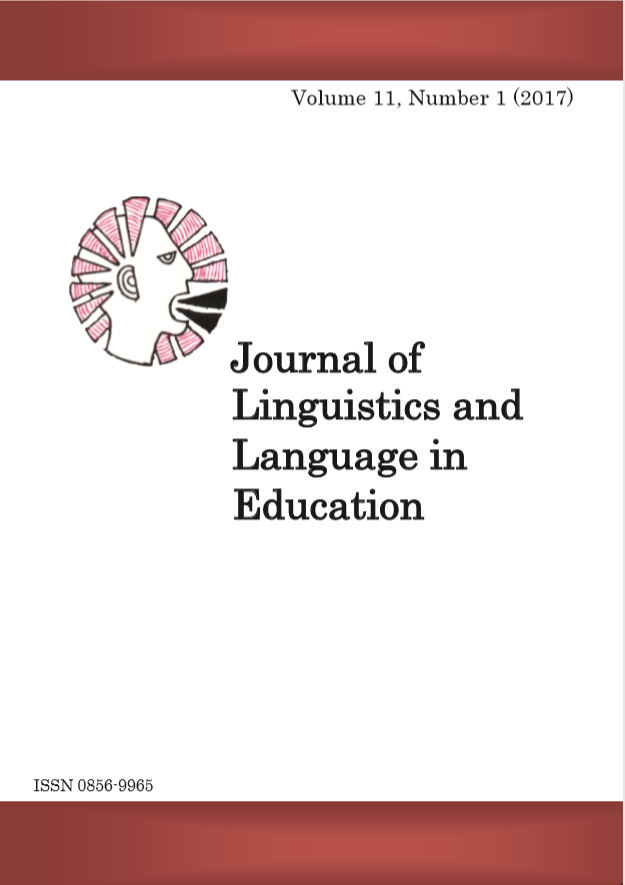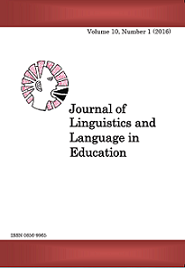Authorial Stance by Academic Writers in an EFL Context: A Case Study of Journal Article Contributors by UDSM Scholars
Abstract
Abstract
The current study assessed different ways academic writers make their
stance towards the findings of and scholarly assertions by other scholars
as well as their findings in their research report writing. The study was
guided by Hyland ' s (2005) academic interaction model. It involved 60
research articles, chosen randomly from fields of humanities, business
studies, natural sciences and engineering sciences. Documentary review
was used as the sole data gathering tool. The findings show that the
authors variously registered their authorial stance notably -under three
categories of stance nouns: relations, attributes and entity, the most
dominant being the category of entity. It was concluded that the art and
science of academic writing by authors in the studied research articles is
generally similar across disciplines .
References
Abdi, R. (2011). Metadiscourse Strategies in Research Articles: A
Study of the Differences across Subsections. Journal of
Teaching Language Skills, 3(1):1-16.
Afsari, S. and Kuhi, D. (2016). A Functional Investigation of Selfmention
in Soft Science Master These. The Journal of
Applied Linguistics , 9(18): 49-64.
Ahmad, U. & Mehrjooseresht, M. (2012). Stance Adverbials in
Engineering Thesis Abstracts. Procedia - Social and
Behavioral Sciences 66: 29 €“ 36.
Alg, S. (2012). Hedges and Boosters in L1 and L2 Argumentative
Paragraphs: Implications For Teaching L2 Academic
Writing. Unpublished Thesis, Middle East technical
University.
Asmuth, J. & Gentner, D. (2005). Context Sensitivity of Relational
Nouns. Proceedings of the Twenty-seventh Annual Meeting
of the Cognitive Science Society , 163-168.
Aull, L.L. & Lancaster, Z. (2014). Linguistic Markers of Stance in
Early and Advanced Academic Writing: A Corpus-based
Comparison, Written Communication, 31(2):151-183.
Biber, D., Johansson, S., Leech, G., Conrad, S. & Finegan, E. (1999).
Longman Grammar of Spoken and Written English. Harlow:
Pearson Education Limited.
Journal of Linguistics and Language in Education Volume 14, Number 2 (2020) |101
Biber, D. & Conrad, S. (1999). Lexical Bundles in Conversations and
Academic Prose. In H. Hasselgard & S. Oksefjell (eds.). Out
of Corpora: Studies in Honour of Stig Johansson (pp. 181 €“
. Amsterdam: Rodopi.
Biber, D. (2006). Stance in Spoken and Written University Registers.
Journal of English for Academic Purposes, 5: 97-116.
Biber, D. (2006). University Language: A Corpus-Based Study of
Spoken and Written Registers. Amsterdam/Philadelphia:
John Benjamins. http://dx.doi.org/10.1075/scl.23
Çakır, H. (2016). Native and Non-Native Writers ' Use of Stance
Adverbs in English Research Article Abstracts. Open Journal
of Modern Linguistics , 6: 85-96.
Casanave, C. P. (2003). Multiple Uses of Applied Linguistics in a
Multi-disciplinary Graduate EAP Class. ELT Journal , 57(1):
-50.
Chang, P. (2015). EFL Doctoral Students ' Conceptions of Authorial
Stance in Academic Research Writing: An Exploratory
Study. RELC Journal , 47(2):175-192.
De Bryun, P. S. (1998). Pragmatiese Merkers: Die Verwaarloosde
Rededeel. South African Journal of Linguistics ' Suid-
Africaanse Tydskrif vir Taalkunde ' , 16(4):127 €“135.
Elisifa, Z. & Kyara, S. (2017). Assessing EFL Learners ' Authorial
Stance in Academic Writing: A Case of OUT Theses and
Dissertations Authors. A Research Report under DRPS
Grants, Open University of Tanzania.
Getkham, K. (2016). Authorial Stance in Thai Students ' Doctoral
Dissertation. English Language Teaching, 9(3): 80-95.
Heather, A. & Quintana-Toledo, E. (2013). Adverbial Stance Marking
in the Introduction and Conclusion Sections of Legal
Research Articles. Revista de LingüÃstica y Lenguas
Aplicadas, l(8):13-22.
Henderson, A. and Barr, R. (2010). Comparing Indicators of
Authorial Stance in Psychology Students ' Writing and
Published Research Articles. Journal of Writing Research,
(2): 245-264.
Heng, C. S. & Tan, H. (2010). Extracting and Comparing the
Intricacies of Metadiscourse of two Written Persuasive
Corpora. International Journal of Education and
Development Using Information and Communication
Technology, 6 (3): 124-146.
Hinkel, E. (2005). Hedging, Inflating, and Persuading in L2
Academic Writing. Applied Language Learning, 15: 29-53.
| Authorial Stance by Academic Writers in an EFL Context
Hinkel, E. (2009). The Effects of Essay Topics on Modal Verb Uses in
L1 and L2 Academic Writing. Journal of Pragmatics, 41:
-683.
Hyland, K. (1998). Boosting, Hedging and the Negotiation of
Academic Knowledge. TEXT, 18(3): 349-382.
Hyland, K. (1999). Talking to Students: Metadiscourse in
Introductory Course Books. English for Specific Purposes ,
(1): 3-26.
Hyland, K. (2000). Hedges, Boosters and Lexical Invisibility:
Noticing Modifiers in Academic Texts. Language Awareness ,
(4): 179-197.
Hyland, K. (2002b). Options of Identity in Academic Writing. ELT
Journal , 56(4):351-358.
Hyland, K. (2005). Stance and Engagement: A Model of Interaction
in Academic Discourse. Discourse Studies, 7(2):173 €“192.
Hyland, K. (2008). Persuasion, Interactions and Construction of
Knowledge: Representing Self and Others in Research
Writing. International Journal of English Studies , 8(2):1-23.
Hyland, K. (2010). Metadiscourse: Mapping Interactions in Academic
Writing. Nordic Journal of English Studies, 9(2): 125 €“143.
Jiang, F. K. (2017). Stance and Voice in Academic Writing: The
"noun + that" Construction and Disciplinary Variation.
International Journal of Corpus Linguistics, 22(1): 85 €“106.
Jiang, F. & Hyland, K. (2016). ' The fact that ' : Stance Nouns in
Disciplinary Writing. Discourse Studies, 17(5):529 €“550.
Kafes, H. (2009). Authorial Stance in Academic English: Native and
Non-Native Academic Speaker Writers ' Use of Stance
Devices (Modal Verbs) in Research Articles. Unpublished
Dissertation, EskiÅŸehir: Anadolu University.
Kibler, A. K. & Hardigree, C. (2017). Using Evidence in L2
Argumentative Writing: A Longitudinal Case Study across
High School and University. Language Learning, 67(1): 75-
Kondowe, W. (2014). Hedging and Boosting as Interactional
Metadiscourse in Literature Doctoral Dissertation Abstracts.
International Journal of Language Learning and Applied
Linguistics World (IJLLALW) , 5(3): 214-221.
Kuo, C. H. (1999). The Use of Personal Pronouns: Role Relationships
in Scientific Journal Articles. English for Specific Purposes ,
(2):121 138.
Maroko, G. (2013). Learning about Author Positioning in Written
Academic Discourse. Argentinian Journal of Applied
Linguistics, 1(2):47-60.
Journal of Linguistics and Language in Education Volume 14, Number 2 (2020) |103
Martin, J. R. & White, P. R. (2005). Language of Evaluation:
Appraisal in English. London: Pal-grave Macmillan.
Mojica, L. (2005). Filipino Authors ' Ways of Showing
Detachment/Commitment intheir English Academic Papers.
In D. Dayag & J. S. Quakenbush (eds.). Linguistics and
Language Education in the Philippines and Beyond: A
Festschrift in Honor of Ma. Lourdes S. Bautista, (pp. 511-
. Manila: Linguistic Society of the Philippines.
Monte-Sano, C. (2011). Beyond Reading Comprehension and
Summary: Learning to Read and Write in History by
Focusing on Evidence, Perspective, and Interpretation,
Curiculum Inquiry, 41(2): 212 €“249.
Msuya, E. A. (2016). Exploring Author Visibility in Academic Writing
in EFL Tanzanian Context: A Case Study of University of
Dar es Salaam Postgraduate Dissertations and Theses.
International Journal of English Language and Literature . 4
(10):55-61.
Myers, G. A. (1989). The Pragmatics of Politeness in Scientific
Articles. Applied Linguistics , 10(1): 1-35.
Nivales, M. L. (2010). Hedging in College Research Papers:
Implications for Language Instruction. Asian EFL Journal .
pp 35-45.
Press, F. (2012). In-text and Out-of-text Engagement: Interactional
Features in Students' Academic Writing and Academic
Engagement. Theses and Dissertations. 180.
Salager-Meyer, F. (1997). I Think that perhaps you should: A Study
of Hedges in Written Scientific Discourse. In T. Miller (ed.).
Functional Approaches to Written Text: Classroom
Applications. (pp. 105-118). Washington: English Language
Programs- United States Information Agency.
Saleem, S. A. (2013). A Corpus Analysis of Stance Marker Use in
International and Egyptian Medical Research Articles.
Unpublished MA Dissertation in TESOL, The American
University in Cairo.
Silver, M. (2003). The Stance of Stance: A Critical Look at Ways
Stance is Expressed and Modeled in Academic Discourse.
Journal of English for Academic Purposes, 2: 359-374.
Starosta, S. (1985). Relator Nouns as a Source of Case Inflection. In
V. Z. Acson & R. L. Leed (eds.). For Gordon H. Fairbanks.
Honolulu: University of Hawaii Press: 111 €“133.
| Authorial Stance by Academic Writers in an EFL Context
Taki, S. & Jafrpour, F. (2012). Engagement and Stance in Academic
Writing: A Study of English and Persian Research Articles,
Mediterranean Journal of Social Sciences, 3(1): 157-177.
Uba, S. Y. (2017). Authorial Stance in Accounting PhD Theses in a
Nigerian University. Unpublished Thesis, School of
Education, University of Leeds.
Uysal, H. H. & Akpınar, K. D. (2008). Cross-Cultural Differences in
Turkish, Japanese and Indian Scholars ' Conference
Abstracts. The 8th International Language, Literature, and
Stylistics Conference, Izmir
Downloads
Published
Issue
Section
License
Copyright © by Department of Foreign Languages and Linguistics, University of Dar es Salaam
All rights reserved. No part of this publication may be reproduced or transmitted in any form or by any means, electronic or mechanical, including photocopying, recording, or any information storage or retrieval system, without permission in writing from the publisher, except for short extracts in fair dealing, for research or private study, critical scholarly review or discourse with an acknowledgement.



